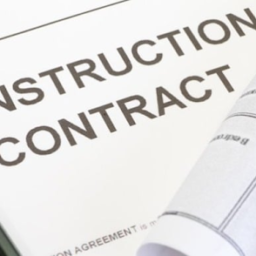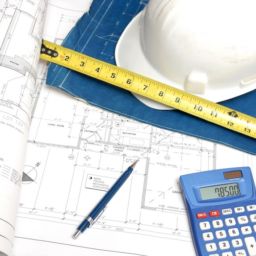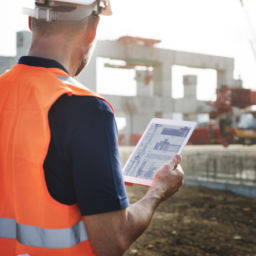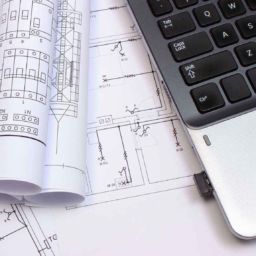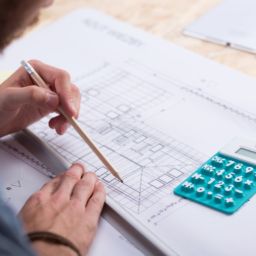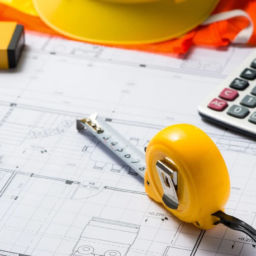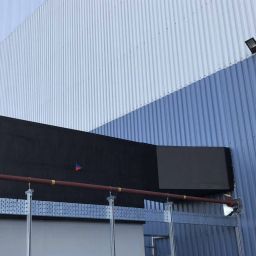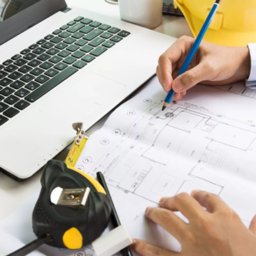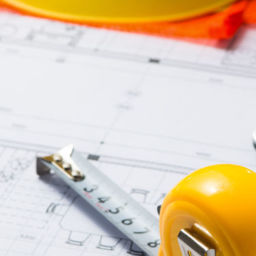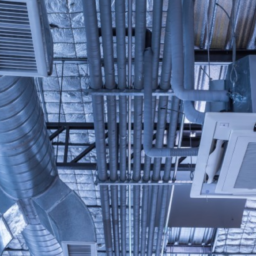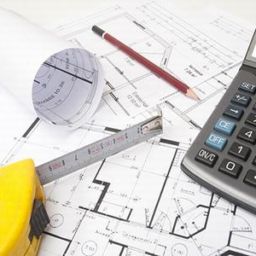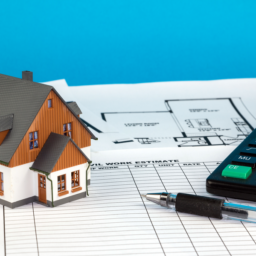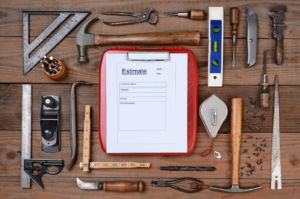
It can be monotonous at times but it is also extremely satisfying to see a completed project which you can be confident will give your company the best chance at making a decent profit from the job.
The key is to be diligent and stay focused while performing a quantity takeoff to produce a precise estimate.
Because we specialise in insulation takeoff along mechanical and electrical takeoffs, we will be referring to common items that are common in these trades, however the advice given is good for all construction estimating.
Takeoffs in construction is the process of figuring out how much of each material will be needed to complete a project. It is also commonly called a quantity take-off or materials take-off.
The estimator quantifies the required materials from construction drawings by measuring how lengths and areas of the particular service they are taking off, for example a run of pipework, and inserts them in the bill of quantities(BOQ). The BOQ is usually just an excel Spreadsheet which gives you line items of each of the materials and tells you how many metres / square metres / quantities there are per line item
Most decent takeoff software would do this automatically with the touch of a button but if the takeoffs are being done by hand the old school way, then manual insertion into spreadsheets will be required, which is time consuming, hence why the industry has more or less moved completely over to dedicated takeoff software like Ensign.
Quantity takeoffs are done for a variety of reasons, such as to create an estimate for a job, to submit a bid, or to determine how much material to purchase. Knowing how much material you’ll need is an essential part of creating an estimate and also helps your guys onsite know what’s been allowed at the tender stage.
When you know how much material you need, you can begin to populate the prices within the software or Spreadsheet and then add things like waste percentage and other costs to your estimate such as delivery charges etc.
As we only use digital takeoff software, we will sometimes refer to the method as on screen takeoff.
So, to provide yourself and your client with the most accurate estimate possible, it is important to approach your takeoffs in a manner which is methodical and diligent, to make sure you don’t miss anything that could be the difference between winning or losing the job or even between making a profit or making a loss.
There are three main types of measurement required for the on screen takeoff in most construction projects.
Count
The estimator will have to count the specific items individually. For example Lighting fixtures, valves, Fan coil units, and other single items of equipment or machinery which you would not measure by length or area.
Length
There are items such as cables and pipes, which need to be measured in linear meters. Same Items with different sizes (diameter) will have to be measured separately.
Area
The estimator may need to measure the surface area of floors, walls, ceilings etc and present in a SQM or SQFT format.
Sometimes you have spent so much time on a job that it can begin to make your eyes hurt and you feel drowsy staring at that screen all day. So do either or even better, all of the below points
- – Take a long break, close your eyes and try to focus on your breathing and empty your mind of thoughts, especially to do with the project. This will help refresh your eyes and mind. Come back and then go over your work and imagine you are checking someone else’s tender, and you’re on the lookout for mistakes. This will help you pick out errors in your own work
- – Even better is to log off for the day and come back and look at it first thing in the morning with fresh eyes and a fresh mind
- – Get a colleague or an outsource estimating service to check your work and identify any errors for you.
Because quantity takeoffs in construction entail a variety of measurements and materials, it’s important to ensure that your numbers and calculations are accurate. To do so, go over your calculations numerous times to make sure you didn’t miss any materials or make a calculating error.
It’s a good idea to distribute your quantity takeoff drawings to project managers before and during the project delivery. It will allow them to see what was allowed at the tender stage, and alert senior management to significant changes which may warrant variation orders (or change orders for our North American readers) as designs may have changed since the tender was won, which may have been months ago.
The importance of construction takeoffs for projects can be summed up as follows:
Determine project feasibility: Quantity takeoffs provide estimators an accurate understanding of how viable a project is based
In Fact the initial first hour or so of takeoffs can give a fair idea of whether the project should be pursued or not as wasted time at tender stage could be better spent chasing projects which have a better chance of being won or that are feasible to be completed with the labour that will be forecasted to be available at the time of project delivery.
Estimate profit: Estimators need to compile all the prime costs required for the project, add in overhead and profit markups to work out how much profit potentially be made from the project.
It’s best practice to try and forecast worst case and best case scenarios along with the average of the two, so you can decide if the correct markup has been applied depending on the nuances of the job.
Provide information on how much material to buy: Quantity takeoffs provide, as their name suggests, quantities of how much material should be purchased throughout the job so budgets can be set and monitored by project managers and bookkeepers alike to prevent overruns eating into profits.
Improving your construction takeoffs for any project has the potential to improve your bottom line as less time is spent estimating, the tenders are more accurate and therefore profits will increase as a natural byproduct.
Save Time – Time is money, whether that be paying an estimator for their time or spending less time doing the tenders yourself, if you can get it done quicker it will cost you less in either money or time.
When quantity takeoffs are accurate and practical at the same time, a smoother pre-construction planning process is assured, empowering you and all of your team to efficiently fulfil ambitious deadlines.
Increased Budget Confidence – For beginners or novices, improving your quantity takeoffs can significantly increase budget certainty while also lowering the chance of inaccurate estimates. You can be certain with your bids, which allows you to negotiate harder and with more confidence if you’re asked by your client to revise your costs.
Build Trust – In a construction project, communication and trust are critical components. Any team’s confidence and rapport will increase as a result of more accurate quantity takeoffs, including client and vendor connections.
Your build team is given more confidence in the fact that what they are doing has been predicted and accounted for at the tender stage.
Clients will also have way more confidence in your ability to deliver a project if you give them quantity takeoff drawings at tender stage, showing your ability to properly account for all required costs.
Last thing a client wants is you to realise when your half way through the job that you have dropped a clanger and missed off important components, which results in you either going to the client with you hand out asking for an extra order or even worse, for you to pull off the job and/or go broke in the process! It happens, I’ve seen it happen.
There are a number of important elements in the quantity takeoff process that can significantly improve accuracy and efficiency. The five most effective strategies that improve takeoffs are listed below.
1. Using Construction Takeoff Software
There are two main types of takeoffs – Manual takeoff & On screen takeoffs.
Many companies still use traditional paper drawings and plans. Even though manual takeoffs can produce accurate estimates, they can be complex & time-consuming. Lets face it, computers speed up everything and for me there’s no excuse to be using the old ruler and pencil method in this day and age.
There is takeoff software that you can use to do takeoffs faster. Using takeoff software allows you to estimate faster and a lot more accurately, resulting in a higher profit down the road. Even if you are stuck in your ways, learning how to use on screen takeoff software is easy and intuitive.
The problem with printed drawings is that they are difficult to organise when there are piles of them lying around. It can even be challenging to find the right one! You also need a printer large enough to print huge drawings so you can have the plans blown up to a size where you can get your ruler out and start noting down the measurements by hand. You then have to get your calculator out and add up all the sums. Its bad for the environment, having to use huge pieces of paper when you could keep it stored on a computer
With on screen takeoff software, you simply need to search for the project name and the blueprint will appear right away. Both manual and digital processes are extremely similar, but the biggest difference is that software has automated many of the more complex, time-consuming tasks.
For instance, the biggest hurdle when you do a manual takeoff is to finish up the job without counting errors such as counting the same item twice or missing something. This can be easily overcome by using takeoff software. There are even auto counting options available in many of the estimating software, mostly for electrical items at this stage though
You are able to create shortcuts to takeoff commands & the options to copy & paste will make your job super easy when you digitise your work.
There is also estimating software available in the market which not only helps you with quantification but also to pricing up the jobs, using databases of labour hours and material costs to allow you to add it all up as you take it all off, no more calculator required!
You can use our software to estimate projects yourself if you are interested in obtaining favourable discounts from a leading UK estimating software provider, which is exclusive to our company. Please click here to find out more
2. Use a checklist
There has been ample evidence that checklists reduce errors, improve consistency, increase efficiency, 
Checklists are often confused with to-do lists, but they’re quite different. The term checklist describes a series of steps developed for the purpose of managing repetitive tasks and recurring processes. On the other hand, a To-do lists detail what needs to be done.
It’s possible for some steps in the process to be forgotten if there’s no guidance or procedure in place. This may be due to distractions or forgetfulness. If something is forgotten, it is more difficult to recover than if it had been done correctly in the first place.
The purpose of a checklist is to ensure all the steps/actions have been taken. Creating a detailed checklist with different categories is a great way to make sure that you don’t forget anything in your estimate. We can stay more organised by using checklists to ensure we don’t miss any steps.
Each project will be unique but the basic procedure to do a takeoff is the same. Having a pre-job and post-job checklist is always helpful. A pre-job checklist will help you while checking the tender package to know if all the necessary documents are available to complete your estimate.
The post-job checklist will ensure that you do not forget anything while wrapping the job up ready to submit. The checklist list will also make it easier for the estimator to prepare the final notes with all exclusions and qualifications.
3. Always starts with the easiest service/drawings
Every project will be unique and it’s not always easy to understand everything properly at first. By starting with the easiest services/drawings, you will get an idea of the whole project. Once you get the idea, it will feel a lot easier than you first thought.
Also for instance, if there are multiple services in one drawing, start with the easiest service and finish it up before jumping to another service.
As I mentioned earlier, you will also get a feel for if you actually want the job, which you only realise once you’ve gone through some of the drawings properly. So kill 2 birds with one stone, start with the easy stuff and potentially prevent yourself from spending unnecessary hours in front of a computer for a job you don’t even want or can deliver!
4. Make Integrations a Top Priority
Try and use other software that will help with your estimates.
- Cloud storage to keep all your files in a central location and easily accessible, from anywhere in the world
- Project management software to keep all your projects on a Gantt timeline, from tender to delivery with all stakeholders who will be involved with them. A Lot of these PM software can be accessed from a phone whilst on site.
- CRM software to keep track of new and existing clients, along with outstanding tenders that you need to chase feedback on for example
5. Understand Materials Pricing, Products and Fluctuations
Because material prices are subject to fluctuation, it is important to consider all aspects that may affect pricing when calculating expenses.
It’s critical to evaluate both material availability and potential schedule delays, as both have economic repercussions if materials aren’t ordered in a timely manner. If products and supplies have a long lead time, keep that in mind when bidding and remember that you’ll need to plan for it during construction and add in any forecasted increases into your bid. If your unsure what to add in, use recent increases as the bar to set what your future increases should be, maybe adding in a few extra % to cover yourself even further.
Consider the bigger picture here. Quantity takeoffs are essential to winning jobs and staying profitable.
Determine how much time and money you stand to save by implementing new technology and processes which will enhance estimations.
All companies involved in the delivery of projects need to do them in some shape or form. Therefore if you can increase your speed, accuracy and efficiency at completing takeoffs, it can only help you and your company not just in the short term but in the long run too.


Get in touch with our estimating team before your next bid. Email us your request at enquiries@chaseestimating.com or call us at 01630417161. We will promptly get back to you and assure you of a good experience with us.




